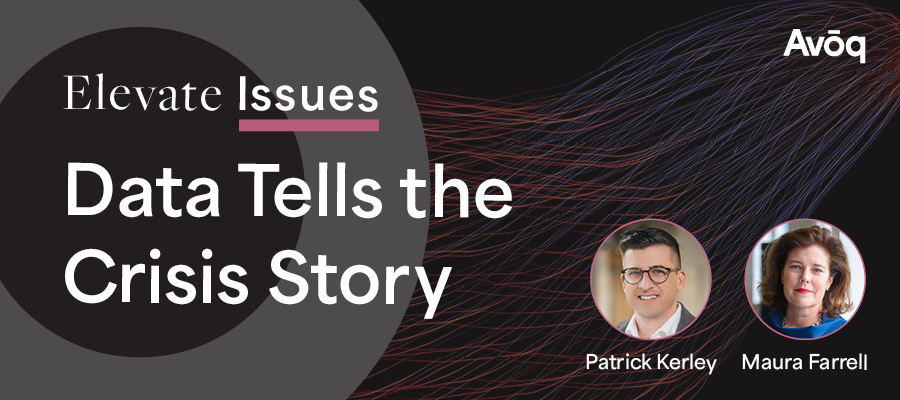What’s the secret to managing a reputational crisis? Having great instincts, communication skills and the ability to see around corners can help. Increasingly, however, it’s also knowing how to harness the power of data and insights.
For CEOs, CMOs, CCOs and General Counsels who are on the spot when something goes very wrong, data can be a critical instrument. Data informs and inspires confidence in decision-making and reassures executives with hard-to-budge points of view. It can reinforce a gut instinct—or push back against assumptions, leading to a different, better strategy.
When is the best time to turn to data and insights in a crisis? All the time. This means creating an advance plan rooted in data that can be rolled out quickly; drawing on data in real time as a crisis unfolds; and using data to inform future situations.
Here’s how data, analysis and actionable insights can be integrated into the three phases of crisis communications.
Phase 1: Before the Crisis
Creating a data-informed preparedness plan starts with monitoring the brand, its issues and stakeholder opinion through online conversations and media content. Who is doing the talking on X (formerly Twitter)? What’s the context? How much engagement does that news outlet get online?
Common themes and insights will emerge, creating robust benchmarks that can inform decision making and provide needed context when an issue arises. In addition, identifying the influential voices in the brand’s space and building proactive relationships with them allows for faster outreach and greater chance of being heard.
That covers some of the basics—the data sources public relations experts and marketers think about every day. But there are more. This is also the best time to identify alternative data sources. Take a look at all the inputs, from call center reports to website product reviews. Understanding what’s happening in these channels can help gauge the situation on the ground and lead to a more strategic response. For instance, identifying the most common questions people ask customer service can help a company understand an emerging issue and proactively address it—avoiding crisis—or translate into social media posts hitting at the biggest public concerns if a situation escalates publicly.
Also useful is pulling data that reveals how others have managed crises, for better or worse. Analyzing what is available publicly about a peer’s or competitor’s recent crisis provide important intel into understanding tactics that worked—messages, spokespeople, content formats—and how key constituencies responded and organized. Avoid their mistakes and learn from their successes to help shorten the recovery period for the brand.
Use these learnings from across information sources to build scenarios and pre-determine decision points and when to escalate response. Most are familiar with qualitative factors like an executive being attacked or video of a malfunctioning product. But, using this data, it’s also possible to apply quantitative factors—how many followers does an influencer have or how many more times was a topic mentioned more than normal—to help gauge reaction.
Finally, use this phase to build consensus internally that data is important and the communications team is prepared to use it to provide counsel. Mid crisis is the wrong time to familiarize other stakeholders with data and the signals it creates. Be transparent about how data is being captured, analyzed and utilized to ensure smoother decision making in the moment.
Phase 2: In the Midst of a Crisis
As a crisis unfolds, providing clear, understandable and actionable insights is key. The challenges to this seemingly simple task are myriad: The data comes too fast and is unstructured, facts shift, internal expectations for updates come too often, and more. Answering these needs often requires different “sizes” of monitoring, analysis and reporting.
At the high level, real-time dashboards provide the ability to visually inspect data and detect general trends—changes in conversation volume, top themes and most influential voices. These can be helpful in the hands of a seasoned team who have experience with the specific issue or crisis comms in general and understand the context and general lifecycle of issue management.
While dashboards can help keep the pressure for real-time data in check, detailed analysis by an experienced insights team is critical. For example, volume of conversation isn’t always enough to know how a crisis is evolving. Often, online engagement consists of sharing headlines without going much deeper. An assessment of the level and tone of the original commentary, and if speculation and misinformation are being spread, can be stronger signals of the public’s true investment in an issue.
Putting out a pulse poll can be another way to gather data in the moment. Standard research can take weeks to develop and deploy, while shorter-format online polling can provide fast feedback on current sentiment and test potential messaging to determine next steps. Over time, a series of pulse polls can track progress on key indicators and suggest a path forward after the situation has de-escalated.
As the data unfolds, the next step is to evaluate the best ways to respond, whether prioritizing media outreach or suggesting the best channels or influencers on social media. In crisis, go to where your audience is getting information and the conversation is happening. Monitoring for activity, then reaching out in the same thread or platform, can help address concerns quickly and advance a response. This may require a mix of media channels—earned, paid, owned, etc.—that you don’t traditionally use. What’s most important is to identify how and where to best reach your audience.
Phase 3: Post-Crisis
Often, new data emerges during the post-crisis phase, so it’s important to continue monitoring, evaluating and reporting. This has the side benefit, too, of helping to reassure executives that their CMO or CCO is still mindful and on top of the issue. The vehicle for ongoing reporting is an impact report that evaluates the crisis; data from these reports can help identify new ways to respond in the future.
Another tactic is a tracking poll, which allows regular check-ins on brand reputation as it relates to key issues like quality, safety and customer experience. This allows anticipation of future threats and provides insights on how and where to proactively bolster the brand’s reputation.
Finally, a data-driven crisis or reputation management plan needs to be a living, breathing document. Don’t put it on a shelf—update it continuously with fresh insights, such as emerging social media platforms and influencers; new monitoring terms; and by re-aligning on the triggers for escalation.
Refreshing the data and reexamining the plan on a regular basis is also a way to get continued buy-in from stakeholders who aren’t in marketing or communications. And it ensures that the next time a crisis hits, everyone’s ready.




